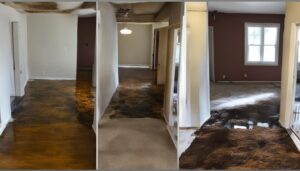Many of us don’t think about the flood risks hidden in our quiet streets. But floods happen more often than we think. They can start from heavy rains, quick snowmelt, or even storm surges. Failures in structures like levees can also cause floods. Human actions, such as building in flood-prone areas, make things worse.
The growth of cities often means more hard, unabsorbent surfaces. This new landscape changes how water flows, making floods worse. Bad maintenance of stormwater systems and building in risky areas add to the problem. As climate change brings more extreme weather, flooding risks go up. It’s crucial to understand these causes to protect our communities from floods.
Key Takeaways
- The variety of factors contributing to flood damage include both natural events and human activities.
- Developed areas with impermeable surfaces and inadequate stormwater management heighten flood risks.
- Flood risk factors are exacerbated by climate change, leading to more extreme and frequent flooding events.
- Understanding how these flood causes interconnect is essential for mitigation and preparedness strategies.
- Proactive steps need to be taken to address the underlying flooding impacts and protect vulnerable areas.
Natural Causes of Flooding and Subsequent Damage
Flooding happens due to many reasons in nature and can be quite damaging. It’s key to know why floods occur to get ready and lessen the damage. Let’s explore the top reasons for flooding:
- River flooding: This usually comes from heavy rains and quick snowmelt. As rivers fill up, excess water spills over. This causes a lot of harm to towns and farm fields nearby.
- Coastal flooding: During hurricanes, storm surges are a big problem. The surge, combined with the tide, can push water levels much higher. This leads to major flooding in coastal zones.
- Flash floods: They happen quickly, often within six hours of heavy rain. Flash floods move swiftly and can destroy roads, bridges, and even buildings.
- Ice jams: Big pieces of river ice forming a block can cause water to back up. When this blockage breaks, it can flood areas downstream intensely.
These flooding types can greatly affect people and economies. They cause death, ruin property, and interrupt daily life. Quick and unexpected incidents like flash floods and ice jams need good planning to handle them.
The place and its environmental set-up can make flood situations worse. For instance, cities with bad drainage may face flash floods more often. Also, areas near rivers are at higher risk of flooding when there’s a lot of rain or snow.
It’s very important to deeply understand these natural events and keep an eye on them. This knowledge helps improve our reaction to disasters and makes communities stronger in facing flood threats.
Human Factors Exacerbating Flood Risks
Expanding urban areas have changed the natural landscape. This leads to more frequent and severe flooding. Urbanization’s impact, impermeable surfaces, and building on floodplains all disrupt normal water flow.
Cities growing larger means more areas covered in materials like asphalt and concrete. Rainwater can’t soak into these, causing more water to run off. This puts a strain on stormwater systems and raises the flood risk in cities and suburbs.
- Impermeable Surfaces:
- Parking lots, rooftops, and streets stop water from going into the ground.
- This makes water build up quickly, which can flood areas and overwhelm drains.
- Floodplain Construction:
- Building homes and businesses on floodplains puts them at higher flood risk.
- This also means less space for water to naturally go during big storms.
- Inadequate Stormwater Infrastructure:
- Not keeping up with maintenance and using old designs leads to more floods.
- In very bad storms, like Hurricane Ida, these systems can’t cope, causing severe urban flooding.
To lower these risks, we need to rethink how we plan and build in cities. This includes adding green spaces that can soak up rain, keeping stormwater systems up to date, and not building on floodplains. These measures help lessen flooding’s impact and make communities stronger against future floods.
Rapid Onset Flooding and Its Potential for Damage
Rapid flooding events, known as flash floods, are very dangerous because they happen quickly. They occur after heavy rains or when something breaks, like a dam. This kind of flood can cause a lot of damage fast, putting both towns and the countryside at risk.
Flash floods come from a mix of weather and the shape of the land. A quiet stream can turn into a force of nature in no time. This has big consequences for the people who live there. Here are some common reasons these floods happen:
- Heavy rain that falls too fast for the ground to soak it up.
- Dams or levees breaking, letting out a huge amount of water at once.
- Landscape features like deep valleys can speed up the water’s movement.
- Cities with lots of paved areas are at risk because the water can’t sink in.
Flash floods can cause a lot of harm, from harming people and their homes to wrecking nature and economies. Every time it happens, it reminds us of the importance of being ready and having a good plan to deal with the aftermath.
Flood Damage in Various Geographical Landscapes
Geographical features play a big role in how floods happen and their impact on places. Urban areas with lots of buildings and roads see urban flash floods when it rains hard and fast. This overwhelms the storm drains, causing sudden and severe flooding. On the other hand, landscape-related flooding covers large areas slowly over time. This can harm farming and rural areas for a long time.
Natural places like river basins and mountains are hit hard by floods too. River overflow happens after lots of rain or when snow melts fast, covering nearby areas with water. The 1993 floods on the Mississippi River show how serious this flooding can be. In high places, mountaintop floods are dangerous. They happen fast, with steep areas making water quickly run downhill, causing erosion and danger to those below.
- Urban areas: Flash flooding from blocked drainage
- Riversides: Extended flooding from overflows
- Mountain regions: Swift floods with severe soil erosion
To tackle flood risks, it’s key to know how different places are affected. This helps in making plans to protect each area effectively.
Climate Change and Its Role in Increasing Flood Events
Climate change is hugely affecting flood patterns worldwide. This is due to sea level rise and more precipitation. These impacts go beyond the environment, influencing how we live and work. It’s seen in things like climate gentrification.
In places like Miami, more and more people are seeing nuisance floods. These are floods that come on sunny days and are thanks to sea level rise. It shows how climate change is hitting us in our daily lives. Plus, more moisture in the air is causing heavier rain. This makes floods worse, as we’ve seen in California with huge storms known as atmospheric rivers.
- Climate change flooding leads to stronger and more storms.
- Increased precipitation raises the flood risk in places not hit before.
- Sea level rise means more coastal and nuisance floods.
- Climate gentrification is changing where people live to avoid floods.
These changes in our climate mean we must rethink how we plan and live in our cities. We need to find ways to be ready for more floods and the changing weather.
Conclusion
The mix of natural forces, our actions, and climate change makes flood problems serious. We need to think about prevention and better ways to deal with floods. Moving towards sustainable development helps us fight back against the troubles floods bring. This means we must improve our buildings, cities, and the ways we protect our coasts. This makes our lives safer and saves our things from harm.
Floods are happening more often and are more severe. This makes being ready for disasters very important. We need to make our defenses stronger and teach people what to do. Leaders and planners have to make sure their flood plans match what local people really need and want.
To protect our communities, we must always be ready for disasters. We need to be serious about making our lives sustainable and preventing floods. Everyone needs to work together, including people, towns, and governments, to make this happen. If we focus on making these changes, we can make our homes safer from floods. Looking ahead, fighting natural disasters depends on these hard efforts we make now.









